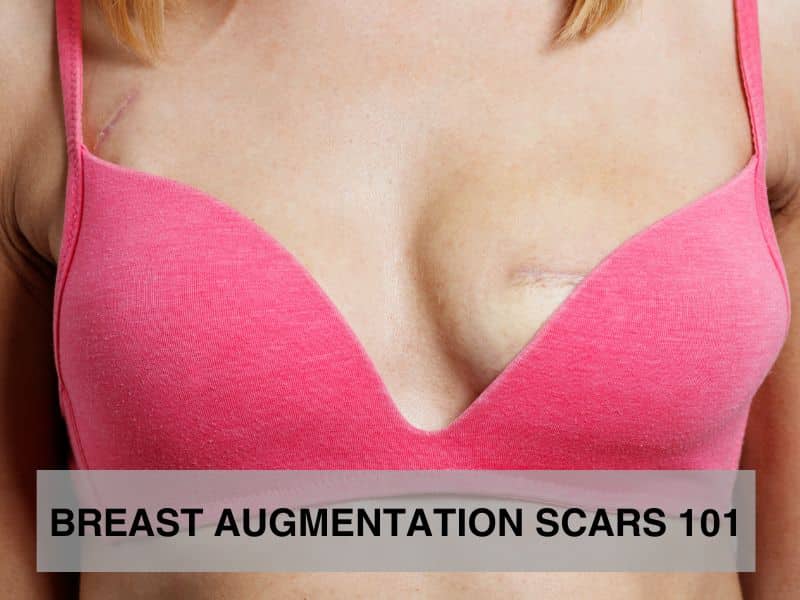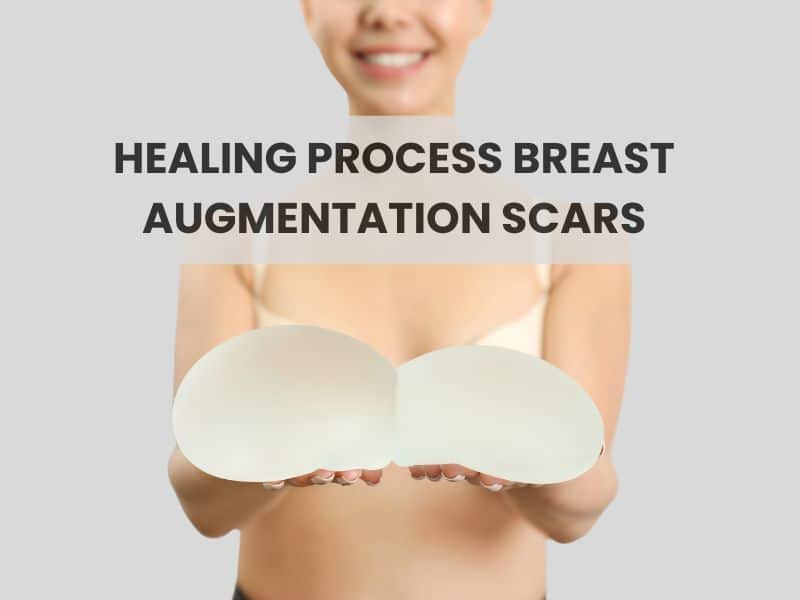
Breast augmentation scars are a common aesthetic concern for patients who desire larger breasts with implants. But as anyone who’s researched breast implants knows, a plastic surgeon must create an incision site when performing breast augmentation surgery because they need a place to insert the implants. This, of course, leads to scarring.
The good news is that scars after breast augmentation surgery don’t have to be a huge problem. Most patients can achieve the look they desire without ending up with severe scarring. In fact, the vast majority of patients end up with faded, hard-to-see scars that they completely forget about in a few years.
But if you’re still concerned about breast implant scars, read on. Below, we’ve created a simple outline to guide you through what you can expect in regards to scars after breast augmentation.
Why Do We Scar?
Before we dive into the various types of breast augmentation scars, let’s discuss scars, in general. Why does our skin scar when it is cut or broken?
First of all, our bodies are amazing. When you get a cut or scrape, your body jumps into action to commence the healing process.
Scar tissue made primarily from collagen is immediately created to fill the gaps and repair damage. Unfortunately, the new scar tissue that forms does not look and feel exactly like the old skin. But of course, the good news is that your wound or incision site will be safely closed, protecting your body from potentially dangerous bacteria and possible infections.
What Do Breast Implant Scars Look Like?
Breast Augmentation Scars Directly After Surgery
Right after breast implant surgery incisions are newly closed, the scars tend to be pigmented (pink or red), slightly raised, and a bit swollen. They are tender to the touch and very delicate. Patients must take care not to strain their incision sites or they may risk reopening the scar.
Breast Augmentation Scars After 6 Months
During the initial healing process breast augmentation scars should become less noticeable. Taking care of your scars during this period is very important. Most breast implant surgeons recommend using silicone sheets or gels, and, importantly, staying out of the sun.
Breast Augmentation Scars After 1 Year
Once you are out from your surgical procedure by at least 1 year, you should notice significantly less prominent scars. Most scars will have faded to blend with your natural skin tone. Some patients with naturally darker skin may end up having darker scars while lighter-skinned individuals will generally notice their scars becoming pale.
Fat Transfer Breast Augmentation Scars
Fat transfer breast augmentation involves a two-step process. First, liposuction harvests fat from a body area, such as the abdomen or thighs. Next, the fat is processed and injected into the breasts.
The small surgical incisions used for liposuction are strategically placed to minimize visibility, resulting in inconspicuous scars that are often easily concealed by clothing. Unlike breast augmentation incisions, which do usually have a scar appearance over time, fat transfer breast augmentation incisions typically result in practically invisible scarring.
Types of Breast Augmentation Scars
 1. Inframammary Incision
1. Inframammary Incision
Inframammary incisions are made in the breast crease (the inframammary fold). Plastic surgeons tend to like this option because it makes accessing the breast pocket easier for breast implant placement. It’s also fairly easy to conceal.
2. Periareolar Incision
Periareolar incisions are made around the outside of each areola. Because this pigmented area changes color to the natural skin tone at this spot, it can be an ideal place to conceal an incision scar. Some surgeons do not like it, however, as it risks short- or long-term changes in nipple sensation.
3. Transaxillary Incision
Transaxillary incisions are made in the armpit crease, which a lot of patients appreciate as it leaves their entire breast and areola area free from any type of scarring. It can, however, be a challenge for breast augmentation surgeons to precisely place implants from his access point. Likewise, if a breast implant revision is needed down the line, it may require new scars to be made.
4. Transumbilical Incision
Lastly, transumbilical incisions are made inside the belly button. This may seem like a bizarre location for a breast augmentation incision, but it does work when the surgeon is especially well-skilled at this technique.
Because few surgeons are, however, it is rarely performed. Despite leaving a virtually scarless appearance, this option does have one specific downside, which is that implant placement can be difficult because, like the transaxillary approach, the access site is remote from the breast pocket.
How Long Does It Take for Breast Augmentation Incisions to Heal?
Healing from breast augmentation is a gradual process, and the timeline varies from patient to patient. In general, most breast augmentation incisions close within the first few weeks, but the full healing process takes several months.
In the first two weeks, the incisions will be in the early stages of healing. During this time, it’s essential to follow your surgeon’s aftercare instructions, avoid strenuous activity, and keep the area clean to prevent infection.
By the six-week mark, the scars should be well on their way to fading, and you may be cleared to resume more physical activities. However, the scar maturation process takes much longer. Most scars will continue to fade for 6 to 12 months, and in some cases, even longer.
To ensure optimal healing, it’s crucial to follow post-op care recommendations, such as protecting your scars from the sun and using silicone-based scar treatments if recommended by your surgeon.
Breast Implant Scar Healing Timeline
Understanding the healing timeline can help you set realistic expectations for your breast augmentation scars. Here’s a general breakdown of what you can expect:
- Weeks 1-2: The incisions are still fresh, slightly raised, and may appear red or pink. To prevent complications, it’s crucial to keep them clean and avoid unnecessary movement.
- Week 3-6: Scars begin to flatten and lighten slightly. Some itching and tenderness may still be present, but swelling should subside.
- Month 2-3: Scars continue to fade and soften. You may start using silicone sheets or other scar treatments as recommended by your surgeon.
- Month 6: Scars are noticeably lighter and less raised. Proper scar care during this period is key to achieving the best long-term results.
- Month 12+: Most scars have faded significantly and blended with the surrounding skin. While they may not disappear completely, they are often barely noticeable.
With proper care and patience, breast augmentation scars can fade beautifully over time. If you have concerns about the healing process or want to explore scar treatment options, consult with your plastic surgeon for personalized recommendations.
How Can I Reduce Scarring After Breast Augmentation? Top Tips
Here are some tips for treating breast implant scars so that they are as hard-to-see as possible:
- Follow your surgeon’s post-op instructions for optimal healing.
- Consider using silicone sheets or gels to improve scar appearance.
- Shield incision areas from direct sunlight for at least one year.
- Consider gentle massage, if cleared by your surgeon, to soften and flatten scar tissue.
- Maintain proper hydration and consume a balanced diet to support the healing process.
- Engage in light, regular physical activity to improve circulation and promote healing (once cleared by your surgeon).
- Avoid smoking and excessive alcohol.
- Be patient! Scars typically flatten and lighten over time.
- Communicate with your surgeon. Get advice on scar management throughout your recovery, and be sure to alert them if you have concerns about keloid scars or hypertrophic scars.
Q&A: Breast Augmentation Scars
 Are breast lift scars the same as breast implant scars?
Are breast lift scars the same as breast implant scars?
No, breast lift scars tend to be more noticeable than scars from breast implants because tissue and skin must be removed with a breast lift. This depends on the incision technique used, however. Every breast enhancement surgery is unique.
What is the best scar for breast augmentation?
Most plastic surgeons like the inframammary incision for breast augmentation surgery. It is easy to conceal, allows convenient access to the breast pocket for good implant placement, and, if needed, makes revision surgery simpler (often, the same initial breast augmentation incisions can be reused).
What do boob implant look like?
Some breast implants are round, resembling a full, symmetrical shape. Others are designed to mimic the natural contour of a breast, often in a teardrop shape—fuller at the bottom and tapering toward the top.
Do scars from breast implants go away?
Breast implant scars typically take about 6 to 8 weeks to heal initially, but it can take a year or more for them to fully mature and fade significantly.
Will insurance pay for breast implant removal?
Insurance may cover breast implant removal if it’s medically necessary, such as in cases of rupture, severe capsular contracture, chronic pain, infection, or BIA-ALCL (a rare cancer linked to implants). However, removal for cosmetic reasons or unexplained symptoms is usually not covered. Check with your insurance provider to understand your specific coverage and required documentation.
Do breast implants ever look natural?
For women seeking a fuller bust while keeping a natural look, the choice of implant type, shape, and placement plays a key role in achieving seamless, proportional results that complement their existing curves.
Set Up a Consultation Appointment Today
If you’ve been thinking about undergoing breast augmentation surgery but are worried about scarring, or concerned about breast augmentation risks, remember that by choosing the right surgeon, you are already setting yourself up for success.
Board-certified plastic surgeon Dr. Raja Mohan is extremely skilled and experienced with breast augmentation procedures. To schedule your consultation with Dr. Mohan today, please give our Dallas practice a call today.
References